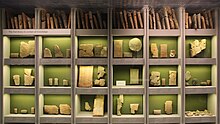
Ancient text corpora are the entire collection of texts from the period of ancient history, defined in this article as the period from the beginning of writing up to 300 AD. These corpora are important for the study of literature, history, linguistics, and other fields, and are a fundamental component of the world's cultural heritage.
Chinese, Latin, and Greek are examples of ancient languages with significant text corpora, although much of these corpora are known to us via transmission (frequently via medieval manuscript copies) rather than in their original form. These texts – both transmitted and original – provide valuable insights into the history and culture of different regions of the world, and have been studied for centuries by scholars and researchers. Other ancient texts – particularly stone inscriptions and papyrus scrolls – have been published following archaeological research, notably the cuneiform corpus of c.10 million words and the c.5 million words in ancient Egyptian.
Through advances in technology and digitization, ancient text corpora are more accessible than ever before. Tools such as the Perseus Digital Library and the Digital Corpus of Sanskrit[1] have made it easier for researchers to access and analyze these texts.
- ^ "Digital Corpus of Sanskrit (DCS) - Online Sanskrit dictionary and annotated corpus". www.sanskrit-linguistics.org. Archived from the original on 2023-06-03. Retrieved 2023-06-03.
© MMXXIII Rich X Search. We shall prevail. All rights reserved. Rich X Search
